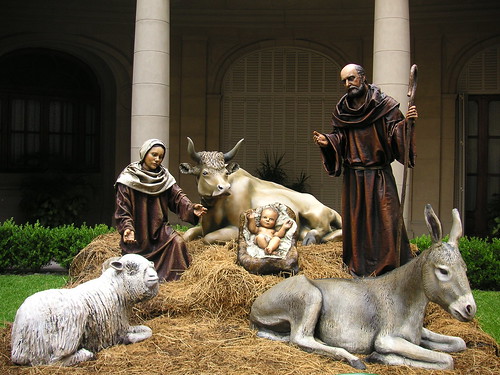Breaking Christmas, but not beyond repair

Everything about Christmas is fragile, especially at a
2-year-old's eye level.
Shiny gold and red ornaments. Tapered candles. The
special crystal and glassware and dishes. Candy canes.
Colored lights.
All the Christmas paraphernalia cries out to be
inspected more closely, touched, handled and
experienced fully.
But they can break - so, no.
They sparkle, shine, tempt, invite. But - no! Too
fragile. Keep your hands away. No, no, no.
Laurie, 2, stands on tiptoe, gazing in toddler
adoration at ceramic Nativity figures.
"Could I play with the breakable people?" she asks.
Shepherd, angel and wise men are simply "the breakable
people." It's sad, but that is her name for them.
She has heard the Christmas story and knows "Away in a
Manger." She wants more. She wants to move closer, to
see firsthand the scene of the Nativity, to touch the
jeweled turban of Wise Man No. 1, to feel the glazed
wool of a sheep.
She also wants to know more about that "Lord Jesus"
she only hears about in stories and songs, the little
curious figure in a manger.
Do I tell her, "No! Too breakable. Stay away"? After
all, when her brother was her age, he threw the baby,
manger and all, across the room once. Do I reinforce
the idea that holy things are beyond reach, available
only for special classes to approach?
Though I don't want her to think of clay figurines as
idols, I also don't want her to think of God as some
cold, distant deity - untouchable, unavailable.
The last thing I want is for her to come away from
Christmas viewing God as unapproachable, an impersonal
force beyond the stars, or concerned only that she
doesn't break the rules. She should know that when
this God came, he brought the stars and the heavens
with Him.
I allow her to climb onto a chair for a better view of
the breakable people, against my impulse to preserve a
reasonably nice creche scene. She murmurs in toddler
tones to the cow. A wise man clinks against Joseph. I
cringe and resume washing dishes.
Laurie speaks gently to and for the breakable people.
In a few minutes, though, I see a guilty child
clutching Melchior and chattering about "pieces."
The wise man is intact, but I soon discover that a
shepherd's head is missing. We search.
The decapitated shepherd stands next to Mary, waiting
for his head. A pretty good place to be if your head
is missing. It has rolled a distance beyond the table,
and Laurie finds it.
"Can you fix this?" she asks. When you are 2, all
things can be fixed.
I glue head on body. In half an hour the shepherd
rejoins his party with only a ruffled hat to show for
his ordeal.
That problem solved, Laurie again peers into the
stable. "Lord Jesus is breakable," she observes.
I want to tell her that the figures are not idols,
that this baby is not "Lord Jesus," that the real Lord
Jesus is not breakable.
But I am stopped at the last point.
The real Lord Jesus was, in fact, very breakable.
One big reason for Bethlehem was for God to become
breakable on purpose.
He was not only breakable; He was broken.
This is my body, broken for you.
Broken for us and with us. We are the truly breakable
people. Always shattering ourselves and others, while
pretending we don't need glue.
We break away from what we know is right, crack into
sharp slivers, all the time pointing out the fractures
we notice in others, denying the severity of our own
splintered condition.
Lord Jesus wants to calmly apply red glue that hardens
clear.
Christmas breaks because only when it does can any
life at all be restored.
Broken for you.
But it's only Easter that provides the glue.
Donna Marmorstein 2002
Comments
Post a Comment
I welcome your comments